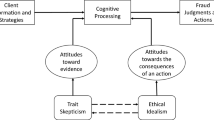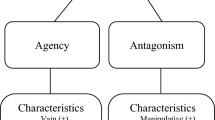Abstract
The recent accounting scandals have raised concerns regarding the closeness of auditor–client relationships. Critics argue that as the relationship lengthens a bond develops and auditors’ professional skepticism may be replaced with trust. However, Statement on Auditing Standards No. 99 states that auditors “should conduct the engagement with a mindset that recognizes the possibility that a material misstatement due to fraud could be present, regardless of any past experience with the entity and regardless of the auditor’s belief about management’s honesty and integrity” (AICPA 2002, Statement on Auditing Standards No. 99, paragraph 13, p. 10). The purpose of this study is to investigate whether auditors develop trust in a client’s management and whether this trust affects auditors’ decisions. Specifically, this study examines whether auditors’ satisfaction with a client’s management during a prior audit engagement affects auditors’ self-reported trust in that client’s management and whether that trust affects their fraud risk assessment. The decision to trust a client’s management should be an ethical decision because excessive trust may impair auditors’ skepticism, which auditors are required to maintain by their professional responsibilities. We therefore also investigate whether auditors’ trust is affected by their moral reasoning. An experimental case was completed by 89 professional auditors, all with experience assessing the risk of fraud. The results suggest auditors’ satisfaction with the client affects their trust in the client (higher satisfaction associated with higher trust and lower satisfaction associated with lower trust). Further, after an overall unsatisfying experience, auditors’ trust affects their fraud risk assessments. However, after an overall satisfying experience, their trust does not affect their fraud risk assessments. The results indicate auditors are able to maintain their professional skepticism after satisfying past experiences with the client regardless of their beliefs about the honesty and trustworthiness of the client’s management. Lastly, auditors’ moral reasoning was not related to their trust in the client’s management.
Similar content being viewed by others
Abbreviations
- AICPA:
-
American Institute of Certified Public Accountants
- CFI:
-
comparative fit index
- CPA:
-
Certified Public Accountants
- DIT:
-
Defining Issues Test
- PCAOB:
-
Public Company Accounting Oversight Board
- RMSEA:
-
root mean square error of approximation
- SAS:
-
Statement on Auditing Standards
References
American Institute of Certified Public Accountants (AICPA): 1997, Consideration of Fraud in a Financial Statement Audit. Statement on Auditing Standards No. 82 (AICPA, New York)
American Institute of Certified Public Accountants (AICPA): 2002, Consideration of Fraud in a Financial Statement Audit. Statement on Auditing Standards No. 99 (AICPA, New York)
Apostolou B., J. Hassell, S. Webber, G. Sumners 2001. The Relative Importance of Management Fraud Risk Factors. Behavioral Research in Accounting 13, 1–24
Armitage C., M. Conner 1999. The Theory of Planned Behaviour: Assessment of Predictive Validity and “Perceived Control” British Journal of Social Psychology 38, 35–54. doi:10.1348/014466699164022
Asare, S., G. Trompeter and A. Wright: 2000, ‘The Effect of Accountability and Time Budgets on Auditors’ Testing Strategies’, Contemporary Accounting Research 17(4), 539–560. doi:10.1506/F1EG-9EJG-DJ0B-JD32
Asare, S. and A. Wright: 2004, ‘The Effectiveness of Alternative Risk Assessment and Program Planning Tools in a Fraud Setting’, Contemporary Accounting Research 21(2), 325–352. doi:10.1506/L20L-7FUM-FPCB-7BE2
Beaulieu P. 2001. The Effects of Judgments of New Clients’ Integrity upon Risk Judgments, Audit Evidence, and Fees. Auditing: A Journal of Practice & Theory 20(September), 85–99
Bell T., J. Carcello 2000. Research Notes: A Decision Aid for Assessing the Likelihood of Fraudulent Financial Reporting. Auditing: A Journal of Practice & Theory 19(Spring), 169–184
Bernardi R. A. 1994. Fraud Detection: The Effect of Client Integrity and Competence and Auditor Cognitive Style. Auditing: A Journal of Practice and Theory 13(Supplement), 68–84
Bollen K., R. Stine 1993. Bootstrapping Goodness-of-Fit Measures in Structural Equation Models. In K. Bollen &J. Long (eds), Testing Structural Equation Model. Newbury Park, CA: Sage Publications. 111–135
Browne M., R. Cudeck 1993. Alternative Ways of Assessing Model Fit. In K. Bollen & J. Long (eds), Testing Structural Equation Model. Newbury Park, CA: Sage Publications. 136–162
Carey P., R. Simnett 2006. Audit Partner Tenure and Audit Quality. The Accounting Review 81(3), 653–676
Cook J., T. Wall 1980. New Work Attitude Measures of Trust, Organizational Commitment and Personal Need Non-Fulfillment. Journal of Occupational Psychology 53, 39–52
Craig S., S. Gustafson 1998. Perceived Leader Integrity Scale: An Instrument for Assessing Employee Perceptions of Leader Integrity. Leadership Quarterly 9(2), 127–145. doi:10.1016/S1048-9843(98)90001-7
Davidson A. S. 1994. Discussion of Fraud Detection: The Effect of Client Integrity and Competence and Auditor Cognitive Style. Auditing: A Journal of Practice & Theory 13(Auditing Symposium), 85–89
Doney P., J. Cannon 1997. An Examination of the Nature of Trust in Buyer-Seller Relationships. Journal of Marketing 61(2), 35–51. doi:10.2307/1251829
Earley C., P. Kelly 2004. A Note on Ethics Educational Interventions in an Undergraduate Auditing Course: Is There an “Enron Effect”? Issues in Accounting Education 19(1), 53–71
Eining M., D. Jones, J. Loebbecke 1997. Reliance on Decision Aids: An Examination of Auditors’ Assessment of Management Fraud. Auditing: A Journal of Practice & Theory 16(2), 1–19
Flores F., & R. Solomon 1998. Creating Trust. Business Ethics Quarterly 8(2), 205–232. doi:10.2307/3857326
Ganesan S. 1994. Determinants of Long-Term Orientation in Buyer-Seller Relationships. Journal of Marketing 58(2), 1–19. doi:10.2307/1252265
Goodwin J. 1999. The Effects of Source Integrity and Consistency of Evidence on Auditors’ Judgments. Auditing: A Journal of Practice & Theory 18(2), 1–16
Hackenbrack K. 1993. The Effect of Experience with Different Sized Clients on Auditor Evaluations of Fraudulent Financial Reporting Indicators. Auditing: A Journal of Practice & Theory 12(Spring), 99–110
Hair J. F. Jr., R. E. Anderson, R. L. Tatham, W. C. Black 1998. Multivariate Data Analysis, 5th edition. Upper Saddle River, New Jersey: Prentice Hall
Herrick, T. and A. Barrionuevo: 2002, ‘Were Auditor and Client too Close-Knit?’, Wall Street Journal, January 21, p. C1
Ironson G., P. Smith, M. Brannick, W. Gibson, K. Paul 1989. Construction of a Job in General Scale: A Comparison of Global, Composite, and Specific Measures. Journal of Applied Psychology 74(2), 193–200. doi:10.1037/0021-9010.74.2.193
Johnstone K., M. Sutton, T. Warfield 2001. Antecedents and Consequences of Independence Risk: Framework for Analysis. Accounting Horizons 15(1), 1–18
Kaplan S. E., K. J. Newberry, P. M. J. Reckers 1997. The Effect of Moral Reasoning and Educational Communications on Tax Evasion Intentions. The Journal of the American Taxation Association 19(2), 38–54
Kee H., R. Knox 1970. Conceptual and Methodological Considerations in the Study of Trust and Suspicion. The Journal of Conflict Resolution 14(3), 357–366. doi:10.1177/002200277001400307
King D. 1960. A Multiplant Factor Analysis of Employees’ Attitudes Toward Their Company. Journal of Applied Psychology 40, 241–243. doi:10.1037/h0042484
King R. 2002. An Experimental Investigation of Self-Serving Biases in an Auditing Trust Game: The Effect of Group Affiliation. The Accounting Review 77(2), 265–284
Knapp C., & M. Knapp 2001. The Effects of Experience and Explicit Fraud Risk Assessment in Detecting Fraud with Analytical Procedures. Accounting, Organizations and Society 26, 25–37. doi:10.1016/S0361-3682(00)00005-2
Kohlberg L. 1969. Stages and Sequences: The Cognitive Developmental Approach to Socialization. In D. Goslin (Ed.), Handbook of Socialization Theory and Research (pp. 347–480). Chicago: Rand McNally
Latham C., F. Jacobs, P. Roush 1998. Does Auditor Tenure Matter? Research in Accounting Regulation 12, 165–177
Lieberman J. 1981. The Litigious Society. New York: Basic Books
Loebbecke J., M. Eining, J. Willingham 1989. Auditors’ Experience with Material Irregularities: Frequency, Nature, and Detectability. Auditing: A Journal of Practice & Theory 9(Fall), 1–28
Mayer R., J. Davis, F. Schoorman 1995. An Integrative Model of Organizational Trust. Academy of Management Review 20, 709–734. doi:10.2307/258792
Messier W. Jr., S. Glover, D. Prawitt 2006. Auditing & Assurance Services: A Systematic Approach 4th edition. New York: McGraw-Hill Irwin
Nicholls J., G. Gilbert, S. Roslow 1998. Parsimonious Measurement of Customer Satisfaction with Personal Service and the Service Setting. Journal of Consumer Marketing 15(3), 239–253. doi:10.1108/07363769810219116
Nooteboom B. 1996. Trust, Opportunism and Governance: A Process and Control Model. Organization Studies 17(6), 985–1010. doi:10.1177/017084069601700605
Peecher M. 1996. The Influence of Auditors’ Justification Processes on Their Decisions: A Cognitive Model and Experimental Evidence. Journal of Accounting Research 34(1), 125–140. doi:10.2307/2491335
Pincus K. 1989. The Efficacy of Red Flags Questionnaire for Assessing the Possibility of Fraud. Accounting, Organizations, and Society 14(1–2), 153–163. doi:10.1016/0361-3682(89)90039-1
Plank R., D. Reid, E. Bolman Pullins 1999. Perceived Trust in Business-to-Business Sales: A New Measure. Journal of Personal Selling & Sales Management 19(3), 61–71
Ponemon L. A. 1992. Auditor Underreporting of Time and Moral Reasoning: An Experimental Lab Study. Contemporary Accounting Research 9(1), 171–189
Ponemon, L. A. and D. R. L. Gabhart: 1993, Ethical Reasoning in Accounting and Auditing (Canadian Certified General Accountants’ Research Foundation, Vancouver)
Rempel J., J. Holmes, M. Zanna 1985. Trust in Close Relationships. Journal of Personality and Social Psychology 49, 95–112. doi:10.1037/0022-3514.49.1.95
Rest J. R. 1979. Development in Judging Moral Issues. Minneapolis, MN: University of Minnesota
Rest J. R. 1993. Guide for the Defining Issues Test – How to Use the Optical Scan Forms and the Center’s Scoring Service. Minneapolis, MN: University of Minnesota
Rest J. R., D. Narvaez, M. J. Bebeau, S. J. Thoma 1999a. Postconventional Moral Thinking: A Neo-Kohlbergian Approach (4th ed.). Mahwah, New Jersey: Lawrence Erlbaum Associates
Rest J. R., D. Narvaez, S. J. Thoma, M. J. Bebeau 1999b. DIT2: Devising and Testing a Revised Instrument of Moral Judgment. Journal of Educational Psychology 91(4), 644–659. doi:10.1037/0022-0663.91.4.644
Ring P., A. Van De Ven 1992. Structuring Cooperative Relationships Between Organizations. Strategic Management Journal 13(October), 483–498. doi:10.1002/smj.4250130702
Rioux S., & L. Penner 2001. The Causes of Organizational Citizenship Behavior: A Motivational Analysis. Journal of Applied Psychology 86(6), 1306–1314. doi:10.1037/0021-9010.86.6.1306
Rotter J. 1967. A New Scale for the Measurement of Interpersonal Trust. Journal of Personality 35, 651–665. doi:10.1111/j.1467-6494.1967.tb01454.x
Shaub M. 1996. Trust and Suspicion: The Effects of Situational and Dispositional Factors on Auditors’ Trust of Clients. Behavioral Research in Accounting 8, 154–174
Shelton S., O. Whittington, D. Landsittel 2001. Auditing Firms’ Fraud Risk Assessment Practices. Accounting Horizons 15(1), 19–33
Tabachnick B. G., L. S. Fidell 2001. Using Multivariate Statistics 4th edition. Massachusetts: Allyn & Bacon
Taylor M. 2000. The Effects of Industry Specialization on Auditors’ Inherent Risk Assessments and Confidence Judgments. Contemporary Accounting Research 17(4), 693–712. doi:10.1506/3LDH-AV52-0F4W-H4BB
Thoma S. J., J. R. Rest, M. L. Davison 1991. Describing and Testing a Moderator of the Moral Judgment and Action Relationship. Journal of Personality and Social Psychology 61(4), 659–669. doi:10.1037/0022-3514.61.4.659
Thorne L. 2000. The Development of Two Measures to Assess Accountants’ Prescriptive and Deliberative Moral Reasoning. Behavioral Research in Accounting 12, 139–169
Tsui J. S. L., F. A. Gul 1996. Auditors’ Behaviour in an Audit Conflict Situation: A Research Note on the Role of Locus of Control and Ethical Reasoning. Accounting, Organizations and Society 21(1), 41–51. doi:10.1016/0361-3682(95)00009-X
Twery R., J. Schmid, C. Wrigley 1958. Some Factors in Job Satisfaction. Educational and Psychological Measurement 18, 189–202. doi:10.1177/001316445801800120
Windsor C. A., N. M. Ashkanasy 1995. The Effect of Client Management Bargaining Power, Moral Reasoning Development, and Belief in a Just World on Auditor Independence. Accounting, Organizations and Society 20(7/8), 701–720. doi:10.1016/0361-3682(95)00018-5
Zimbelman M. 1997. The Effects of SAS No. 82 on Auditors’ Attention to Fraud Risk Factors and Audit Planning Decisions. Journal of Accounting Research 35(3), 75–97. doi:10.2307/2491454
Author information
Authors and Affiliations
Corresponding author
Rights and permissions
About this article
Cite this article
Kerler, W.A., Killough, L.N. The Effects of Satisfaction with a Client’s Management During a Prior Audit Engagement, Trust, and Moral Reasoning on Auditors’ Perceived Risk of Management Fraud. J Bus Ethics 85, 109–136 (2009). https://doi.org/10.1007/s10551-008-9752-x
Received:
Accepted:
Published:
Issue Date:
DOI: https://doi.org/10.1007/s10551-008-9752-x




